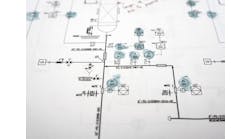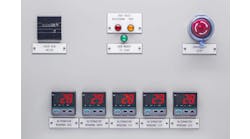This Control Talk column appeared in the November 2021 print edition of Control. To read more Control Talk columns click here or read the Control Talk blog here.
Greg: As a follow-up to Keith Larson’s tribute to the process control legend F. Greg Shinskey in last month’s issue, we wanted to give a more detailed view of the knowledge he shared and how it played such a critical role in the success of the PID controller. Here we ask prominent leaders in the use of process control, Karl Astrom, George Buckbee, Mark Darby, Peter Morgan, Sigifredo Nino, Michel Ruel, Nick Sands, Jacques Smuts and Terry Tolliver to share the impact of Shinskey on their career through examples.
Karl: I knew early that Greg was an expert in process control. When I became professor of a new department in 1965, I asked him for advice on course contents and particularly about building a student laboratory. Greg was tremendously helpful and recommended level control as a simple example that is accessible to all engineers, very useful since we give courses to students in many branches of engineering: mechanical, electrical and chemical. On Greg's advice, we built a two-tank system which has been highly appreciated by our students ever since. I continued the contacts with Greg over the years, he gave me very useful feedback on many things. One example was when Tore Hägglund and I wrote the ISA book Advanced PID Control. I will always remember Greg as an experienced, competent, creative, helpful and very friendly colleague.
George: In my mind, Greg Shinskey was the exemplar of a process control engineer. He was fully steeped in the theory of control yet grounded in the experience and practicalities of the industrial environment. I was most impressed by his ability to quickly whittle any problem down to its pure fundamentals and state the “obvious” solution in just one or two short sentences.
He was also very interested to codify his knowledge and pass it on to coming generations. I was fortunate to have worked closely with Greg during the development of ExperTune’s PlantTriage software. He was very excited to see his knowledge captured in software, automating the troubleshooting and diagnostics of control loops. I will be forever grateful that Greg chose to devote some of his time to share his insights with the rest of us in the process control world.
Mark: I was fortunate to start my control career in 1980 after developing an interest in process control during college. This was at a time when distributed control systems and supervisory computers were coming into greater use. These systems readily allowed the implementation of more advanced techniques, compared to what was previously feasible with analog controls, many of which were developed and/or described by Greg Shinskey in his articles and books. His writings were a major resource for me in developing control applications. A common refrain when discussing an application among my colleagues at the time was: “What does Shinskey say?”
Greg’s advice was particularly helpful to me in the design of distillation column controls, techniques I continue to use today in model predictive control applications. One of the key take-aways from Greg was, of course, the importance of understanding the process. But further, how much additional knowledge can be gleaned from applying basic chemical engineering fundamentals—for example, the use of simplified material and energy balances—to better understand the process or to use directly in control design. This approach is something I fear is being lost today where, for example, model predictive control by itself is sometimes assumed to solve all control problems, or the thinking that a rigorous simulation is the only means of increasing process understanding.
Greg’s insights are timeless—we need to make sure these are passed along to future generations of control engineers.
Peter: Regrettably, I never did meet Greg Shinskey, and because my formation as a control engineer (or systems engineer as I was called in the ‘70s) took place in the U.K., I wasn’t to learn of Greg Shinskey’s work until the ‘80s when I hit the North American shore. His ideas minted in the ‘60s are still the currency of today.
To give just one example, Shinskey recognized that the alternative implementation of PID using filtered positive feedback simplified override strategies and made possible the implementation of external reset feedback to improve loop stability and performance when external dynamic and static limits are present, and when the final element resolution is non-zero. Today, we are seeking to promote the wider use of this method, trusting in his approval. Thank you, Greg, for your inspiration
Sigifredo: On November 16, 1993, Greg wrote in the first blank page of his Process Control Systems - 3rd Edition: “Sigifredo it was a pleasure meeting you in Atlanta” followed by his signature.
I was so fascinated by what I had learned during his three-day course, that as soon as I had the opportunity to do it, I implemented his shrink-and-swell compensator in a boiler that was commissioned at the plant in which I was working at the time. The strategy appears in Figure 9.12 of the fourth edition of the book.
We worked together in the implementation of a PID-deadtime application at a 500-MW gas-fired power boiler. It is a strategy that has scheduling of the proportional, integral, derivative and deadtime parameters of the controller. He wrote a paper that he presented at the IFAC Workshop on Digital Control: Past, Present and Future of PID Control, Terrassa, Spain, April 5-7, 2000. I remember him asking me for the results of the application, which I had successfully commissioned. I told Greg that it had been a success, to which he replied: “You have done so many interesting applications, but you don’t write about them and you should.” I sent him notes with the details of the final strategy and parameters, information he included in the paper.
Ever since I have tried writing as much as time allows. And nowadays first thing I do whenever I am asked to consult is to ask: “Why do you need to do this? Is there a tangible benefit to your organization in resolving or optimizing this process?” then “Please send me all the Process and Instrument Diagrams (P&IDs) and/or Process Flow Diagrams (PFDs) associated with the process you want me to work on.” Those are some of the things I learned, first-hand, from working with Shinskey.
And, last but not least, Greg was a great force behind the practical use of E. H. Bristol’s interaction measure that Shinskey labeled Relative Gain Analysis (RGA). What is less known is that his use of RGA in distillation control was beyond what is typical; in pairings for dual composition control, he recommended not only associated to minimum interaction but, more importantly, on the concept that values higher than 1.0 give better dynamic response. The details can be found in his book Distillation Control, 2nd Edition.
Michel: Greg was my idol, a guru, an icon, a remarkable author, a process controls passionate! It started when I was a student at university, end of ‘70s. My process control professor was very critical of a book by Greg Shinskey, too practical. I was a fan and was surprised by his comments. Later, when I was teaching at the same university, I recommended Greg Shinskey’s book to passionate future engineers (the books were not recommended by my colleagues). Later, at Top Control, every time I hired a new process control engineer, asking them to study Greg Shinskey’s book was one of the first step for their training. Every one of them became a Shinskey fan. Eight years ago, I called Greg to ask him permission to name our main conference room after him. Greg agreed then I took three graphics from his books to display in the room and he told me, Michel, “these 3 graphics are a perfect summary of my whole career.” We trained many engineers in this room and we always started with a story about Greg.
I have hundreds of examples of the role he played in my career. I offer here two. The first was from a discussion on filtering, its impact on measurement, on loop tuning and on valve life. We talked for more than an hour on this simple subject after I presented a paper on filtering. The second example is control strategies for boiler control, specifically shrink and swell. We successfully applied some creative strategies suggested by Greg.
Nick: As an aspiring control engineer, I started to build a library, which has grown to be quite large over 30 years. The early books were critical to helping me better understand the processes I worked with and how to control them. Chief among my favorite authors were Greg Shinskey, Bill Luyben and Greg McMillan. My first copy of Process Control Systems was the 3rd edition, which I wore out and replaced with the 4th edition. A strategy for controlling total flow and ratio solved some critical control problems, both in distillation applications and in mixing applications. When a senior engineer wanted an explanation of the strategy, it was there in the book. It was an honor to meet Greg at some ISA conferences where he was always encouraging and willing to share his knowledge. His works will endure; he will be missed.
Jacques: My first practical book on process control was the 3rd edition of Greg Shinskey’s Process Control Systems. I was inspired and enlightened by his crisp and insightful explanations. Remember? “The Difficult Element – Dead Time; The Easy Element – Capacity.” Stuff just made sense the way Greg explained it. Although we never met in person, I really benefitted from the wealth of information in his books and other contributions. Three topics he covered that come to mind as being directly helpful to me are steam-plant controls, chemical reactors and distillation columns. But he demonstrated great insight in many, many other topics from which I also benefited. Even ones as simple as flow control. He was a great asset to the field of process control and will be greatly missed.
Terry: Greg Shinskey had a significant impact on my career in process control. In 1976, shortly after I transferred into Engineering Technology at Monsanto Headquarters as a process control specialist, I was allowed to attend the course he presented on distillation control at Foxboro. The emphasis he placed on understanding the process while designing the control system served as my guiding principle throughout my career. This was at a time when microprocessor-based controllers were beginning to allow easier implementation of process characteristics into the control strategy. Feedforward control and constraint control were two of the more successful techniques he encouraged and were widely adopted.
Greg: I have six of Shinskey’s books. They have provided key insights on how the understanding of process relationships and control objectives and their effect on dynamics determine strategies and performance. He worked primarily in the time domain providing simple equations and test results for process and automation system dead times, time constants, and gains. While I have a Master’s Degree in control theory with considerable exposure to frequency response, I appreciated being able to relate to dynamics in time units and seeing test results since my career in research and development of modeling and control emphasized the use of first principle relationships often by simple ordinary differential equations (ODE) for material and energy balances. Nearly all of my serious books in the last decade have an Appendix F that details first principle relationships for common control loops.
The equations I got from Shinskey enabled a deeper understanding plus solutions based on fundamental relationships of process and automation system dynamics. He has showed how interacting lags creates dead time and plays a key role in temperature, composition and gas pressure control. He revealed the process gain for temperature and composition control are a nonlinear function of the ratio of manipulated to feed flow resulting in a hidden factor where the process gain is inversely proportional to feed flow. He emphasized that most disturbances enter as process inputs (load disturbances) rather than in process outputs shown in many publications that discount the PID and promote alternatives to the PID. His work, confirmed by an academic paper, showed that the PID was best at rejecting load disturbances, tuning should be done for this and tested by making step changes in PID output while momentarily in manual, and any desired setpoint response can be achieved by setpoint lead/lag or an equivalent two degrees of freedom PID structure eliminating any interaction between load and setpoint response tuning. His equation for integrated error showed the impact of PID tuning settings, execution rate and signal filter on integrated error for a load disturbance. If you realize for lag dominant and integrating processes, the PID integral time in the numerator is proportional to dead time and the PID gain in the denominator is inversely proportional to dead time, the integrated error is proportional to the dead time squared. Any detuning of the PID can be back calculated as an effective dead time greater than the actual dead time. There is also extremely surprising knowledge, such as a hidden control loop being formed creating havoc in an interacting control system. There is one hidden loop for a 2x2 relative gain array (RGA), two hidden loops for a 3x3 RGA, and so forth. If there are negative relative gains, the hidden loop has positive feedback causing instability. While it can be mitigated by reversing the action of one of the visible loops, the response is poor and if one of the visible loops hits an output limit or is put in manual, the other visible loop will develop positive feedback. For this and other reasons, negative relative gains are unsafe.
The charge balance offered by Shinskey in his pH book provides a simple solution and great ability to understand the impact of different acids, bases and conjugate salts on the process gain. I have bought several books on pH including ones on the process engineering that only offered solutions for a particular chemistry. The solution via the Shinskey inspired charge balance by a simple and fast iterative search (interval halving) is the basis of all of my dynamic simulations and solutions documented in my ISA book Advanced pH Measurement and Control.
Shinskey alerted us the development of a limit cycle from backlash in an integrating process that I extended to be an occurrence for self-regulating processes if there was integral action at two points in the control system (e.g., in positioner or in both the primary and secondary PID of a cascade control loop). I got simple equations that enable one to compute the dead time from a digital device with latency and from an analyzer cycle time.
I learned the capability of various simple strategies via valve position control (VPC) to maximize process efficiency and capacity documented in my Control article “Don’t Overlook PID in APC.”
I am increasingly impressed at the capability of external-reset feedback to suppress oscillations from slow secondary loops, slow valves and valve backlash besides offering the ability without retuning to have fast opening and slow closing surge valves, a slow approach to optimum and fast recovery for upsets in VPC, and reducing unnecessary crossings of split range point. Dead time compensation is simpler and as good as a Smith Predictor by the simple insertion of a dead time block in the external-reset feedback. Shinskey alerted me to the unexpected result that dead time compensation offers the biggest benefits for lag dominant processes and the least benefit for dead time dominant processes. Also, high frequency oscillations that often occur can be suppressed by a small filter on the PID output. Additionally, the PID tuning must be made much more aggressive to see the benefit and a model dead time slightly smaller than actual dead time can cause instability whereas a model dead time greater than actual dead time just slows down response reducing the potential benefit.
Shinskey alerted us on how to prevent positive feedback causing a runaway response in steam jets and parallel heat exchangers besides the more obvious case in highly exothermic reactors. I since learned that the jumps to and from negative flow in a surge cycle are due to positive feedback if you realize the shape rarely given of the compressor flow characteristic to the left of the surge point as noted in the Control article “Compressor surge control: Deeper understanding, simulation can eliminate instabilities”.
Shinskey warned us of the problem with throttling the jacket coolant flow for jacket temperature control. At startup and low production rates, the increase in transportation delay in the jacket is horrendous that when combined with the increase in temperature process gain at low flows cause a double whammy seen as a burst in oscillations. Jacket coolant flow should be kept constant and jacket temperature changed by manipulating fresh coolant makeup flow with return flow equal to makeup flow by jacket pressure control.
If reactor temperature control manipulates a reactant flow, there is an inverse response due to the reactant temperature being different than the reactor temperature. The manipulation of reactant flow also changes the beneficial process time constant that is approximately the reactor residence time for well mixed reactor into a detrimental lag slowing down the ability of making corrections. The lesson here, and throughout Shinskey’s publications, is that the location of the process time constant is critical to understanding whether it is helpful or hurtful. You don’t want the time constant to be in the path of the manipulated variable into the process or in the path of measured variable from the outlet of the process (e.g., fouling of sensor). Often testing, tuning and analysis methods do not distinguish the source or location of the process time constant.
For continuous reactor composition completion control, Shinskey offered great knowledge on the control strategies. For a liquid reactor (i.e., liquid reactants and liquid product), level control sets reaction time via residence time, temperature control sets reaction rate, and composition control enforces the stoichiometric ratio for composition control. For liquid and gas reactants and a liquid product, pressure control maintains continuous composition completion and level control maintains the liquid inventory with a liquid purge of inerts. For liquid and gas reactants and a gas product, level control maintains composition completion and pressure control maintains the gas inventory with a gas purge of inerts.
Much of the material in my articles, books, columns and the sections I wrote for the ISA 5.9 Technical Report PID Algorithms and Performance are the result of what I learned from Shinskey. For more details on the impact of Shinskey on the career of me and Sigifredo, see the Control feature article “Greatest source of process control knowledge.” My books not counting my six mostly humorous books are:
- New Directions in Bioprocess Modeling and Control 2nd Edition, ISA, 2021
- Industrial/Process Instrumentation and Controls Handbook 6th Edition, McGraw-Hill, 2019
- Good Tuning: A Pocket Guide, 4th Edition ISA, 2015
- Tuning and Control Loop Performance, 4th Edition, Momentum Press, 2015
- Advances in Reactor Measurement and Control, ISA, 2015
- 101 Tips for a Successful Automation Career, ISA, 2012
- Advanced Temperature Measurement and Control, 2nd Edition, ISA, 2011
- Centrifugal and Axial Compressor Control, Momentum Press, 2010
- Process Control Case Histories, Momentum Press, 2010
- Essentials of Modern Measurements and Final Elements in Process Industry, ISA, 2010 Advanced pH Measurement and Control, 2nd Edition, ISA, 2005
- Models Unleashed, ISA, 2004
- Advanced Control Unleashed, ISA, 2003
- Continuous Control Techniques for Distributed Control Systems, ISA, 1989
- Biochemical Measurement and Control, ISA, 1987
I was so honored to be inducted into the Process Automation Hall of Fame on the same day as Shinskey.
10. Not disturbed by misleading literature on disturbance location
9. Not surprised by backlash from backlash
8. In tune with tuning effect on loop performance
7. No lag in the understanding of lags
6. No delay in minimizing delay from digital devices and analyzers
5. No delay in forgoing transportation delay from throttling jacket coolant flow
4. No confusion in avoiding confusing inverse response from throttling reactant feed flow
3. No residing on unreacted reactants from lower reactor residence time at high production rates
2. More positive feedback from operators by eliminating positive feedback from parallel heat exchangers
1. More positive feedback from operators by eliminating positive feedback from hidden loops







